Finding this hard to believe, Daubenton flowering
Feb 20, 2011 21:01:34 GMT -5
homegrower likes this
Post by mybighair on Feb 20, 2011 21:01:34 GMT -5
The collection mentioned in the paper stevil describes is maintained by Gatersleben, I have most of the available clones from them as it happens.
They all look much the same as the Ehwiger Kohl I have from Frank. I requested them from Gatersleben at the start of last season, in the hope that one of them would flower so I could carry out the kind of crosses I made to Daubenton. As it happened Daubenton beet them to the punch. The cultivar named Zwart was found to be the most genetically diverse form and was believed to have resulted from a cross to a biannual B. oleracea in the recent past, Zwart was also the most consistent in flowering.
All the accession from Gatersleben have been less vigorous, and slower to establish than Daubenton and Ehwiger Kohl were but Zwart was particularly so. I had hoped it would pick up but the winter has finished it off, which is disapointing as I had high hopes for its flowering.
Gatersleben also has a number of seed propagated perennial brassicas, I've grown quite a few of them if not all, and while the majority are to hot/bitter to be palatable I have found one that is very close to theTree Collard that I have from an American ebayer.
I have to agree that Tree Collards and Walking Stick Kale are quite different things although the form of Tree Collard I have is of a similar size to Walking Stick Kale, and kind of looks like a multi stemmed form of it. Leaf texture and taste are far superior in the Tree Collard though.
I can also say that the Tree Collard I have is very different from the Daubenton types. It is much larger, less bushy, with red/purple stemms and darker leaves with purple midribs. It also tastes very different raw and has a fleshier leaf texture (to me at least). The form of Tree Collard I have is also said by the seller to flower every year, and is less purple than the classic description of the Purple Tree Collard. So I'm fairly sure there is more than one form doing the rounds.
As for the origins of Tree Collards in the US, they could have come from the UK I suppose. There are historical references to two or three forms of perennial kale.
One referred to as 'Woburn Kale' is almost certainly lost, but the description is similar to the purple kale in the "perennial kales in Ecuador" link trixtrax posted ( agro.biodiver.se/2009/10/perennial-kales-in-ecuador/ ). 'Woburn Kale' did make it to the US and picked up the pseudonym 'Ragged Jack' shortly after it's arrival. I suspect that the modern 'Ragged Jack' is it's biannual replacement, as seed generated plants are far easier to produce than cuttings. The perennial form was probably dropped. It is possible however that the original form made it to Ecuador and that the red kale in the photograph is Woburn Kale.
Another called simply 'Crofters/Cottagers Kale' is rare but survives. A form local to the area called Taunton Deane (after the borough where it was rediscovered) is grown at 'Knightshayes Court' in Tiverton, Devon. A Victorian walled garden maintained by The National Trust. It was featured on the UK gardening program 'Gardeners World' and it actually fits the classic description of 'Tree Collards' quite well. My 'Tree Collard' actually looks like a cross between 'Crofters Kale' and 'Walking Stick Kale' being intermediate between the two in appearance.
The last form is the 'Hungry Gap'/'Cut And Cone Again' type, which appearers to be the same basic form as Daubenton and Ehwiger Kohl. This one has largely disappeared, it is said to be maintained by one ore two elderly individuals but I have as yet been unable to find anyone growing it. 'Hungry Gap' has also been replaced in commerce by a biannual fodder kale sold under the same name. I haven't found any perennial individuals in the seed I grew out from this commercial form, though it is said to have some perenniality. However, 'Pentland Brig' which is said to be derived from a cross between 'Hungry Gap' (it's not clear if that's the classical or modern commercial form) and 'Curly Scots Kale' did produce perennial individuals, flowering in their second year and then continuing to grow and flower for two consecutive years after the first flowering so far.
As for the fate of the Daubenton and Tree Collard that flowered, they are both alive and well. Neither of them have suffered any dieback after flowering and are growing as vigorously as ever. It's to early to comment on the perenniality of the seedlings but they have made some growth, and though they look a bit tatty they have survived the winter.
The Daubenton X Tree Collard seedlings are for the most part less vigorous than the other two crosses but they are building up nicely. For now there are two basic groups:
Those with coloured midribs.
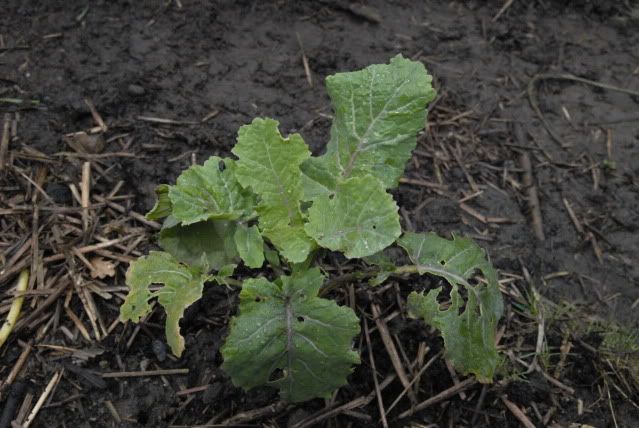
And those with green midribs.
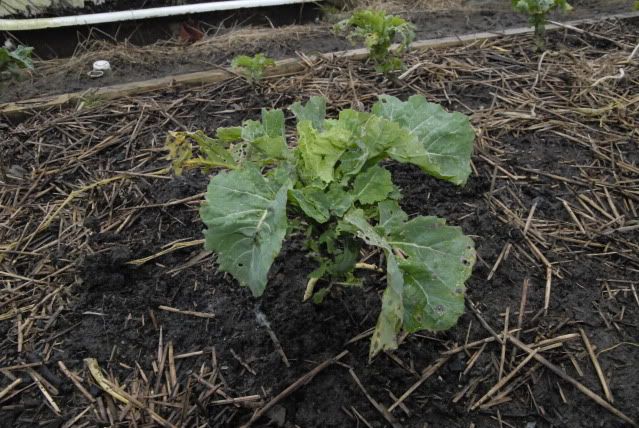
I cant comment to much as to which traits they express from which parents yet, they do look as though they'll be more bushy than the Tree Collard, but have more Tree Collard like leaves.
The seedling from this cross that was reddest is now the greenest and also the weakest of them.
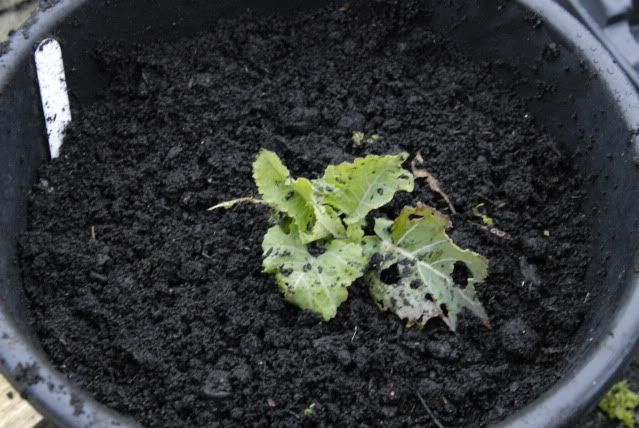
A disappointment but not the end of the world.
The Daubenton X (Black Tuscany X Varigated Collards) look quite like the Black Tuscany X Varigated Collards cross did at this stage, but it look as though they will bush out more. They are split 50/50 for variegated and non variegated leaves.
First the variegated.
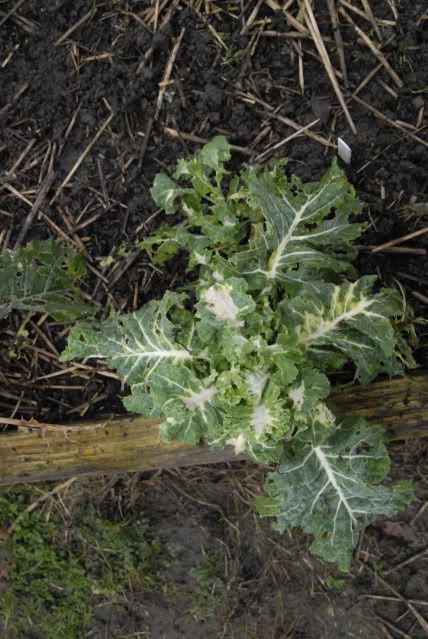
There is one the slugs are fond of that is showing pink/pale purple variation.
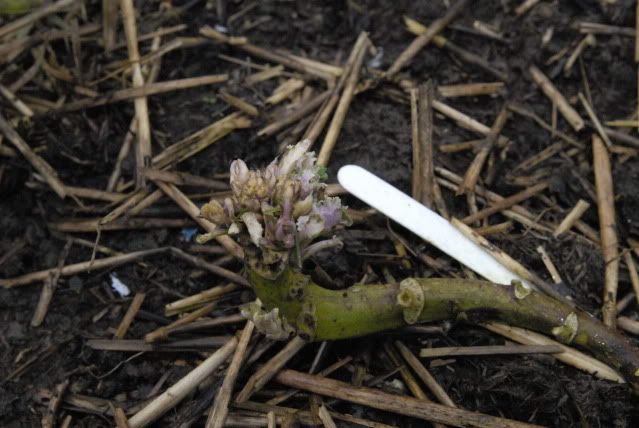
I just hope it survives long enough to flower.
And the non variegated.
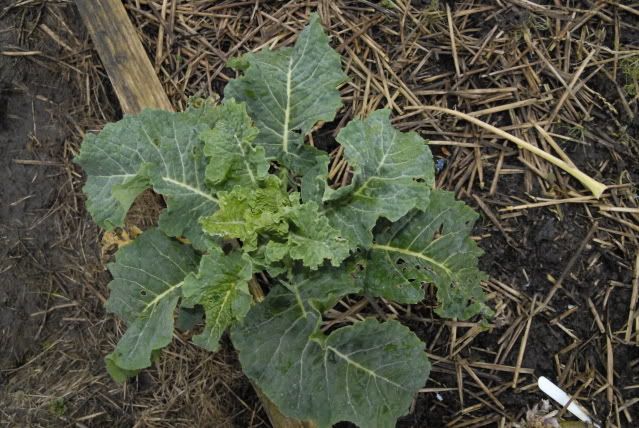
And finally the Daubenton X Red Kale seedlings.
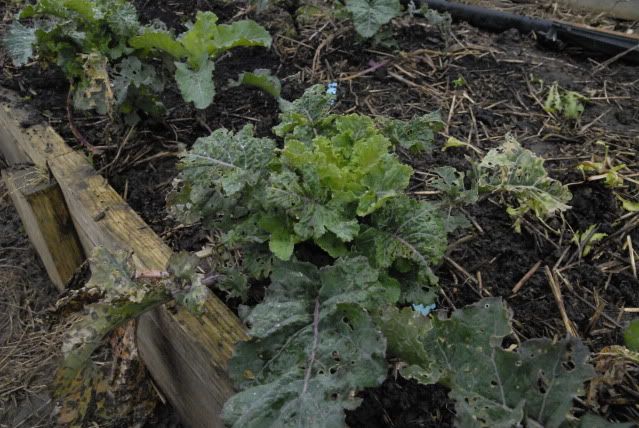

Not as red as I'd like, but I'm hoping that's because Daubenton carries the dominant gene that restricts anthocyanin production to the stem and leaf midribs. If that is the case red leaved individuals could resurface in the F2.
So all in all things are progressing well with this project and with luck I can make some crosses between these F1's this summer and recover perennial plants in the F2.
I'm likely to disappear again for a while now as our baby girl is due to arrive in soon. She could be here by the end of the week if she's as early as her brothers were. So please forgive my absence until things calm down.
I'll be sure to keep a record of how things progress once flowering starts and post some picks and further updates.
All the best.
They all look much the same as the Ehwiger Kohl I have from Frank. I requested them from Gatersleben at the start of last season, in the hope that one of them would flower so I could carry out the kind of crosses I made to Daubenton. As it happened Daubenton beet them to the punch. The cultivar named Zwart was found to be the most genetically diverse form and was believed to have resulted from a cross to a biannual B. oleracea in the recent past, Zwart was also the most consistent in flowering.
All the accession from Gatersleben have been less vigorous, and slower to establish than Daubenton and Ehwiger Kohl were but Zwart was particularly so. I had hoped it would pick up but the winter has finished it off, which is disapointing as I had high hopes for its flowering.
Gatersleben also has a number of seed propagated perennial brassicas, I've grown quite a few of them if not all, and while the majority are to hot/bitter to be palatable I have found one that is very close to theTree Collard that I have from an American ebayer.
I have to agree that Tree Collards and Walking Stick Kale are quite different things although the form of Tree Collard I have is of a similar size to Walking Stick Kale, and kind of looks like a multi stemmed form of it. Leaf texture and taste are far superior in the Tree Collard though.
I can also say that the Tree Collard I have is very different from the Daubenton types. It is much larger, less bushy, with red/purple stemms and darker leaves with purple midribs. It also tastes very different raw and has a fleshier leaf texture (to me at least). The form of Tree Collard I have is also said by the seller to flower every year, and is less purple than the classic description of the Purple Tree Collard. So I'm fairly sure there is more than one form doing the rounds.
As for the origins of Tree Collards in the US, they could have come from the UK I suppose. There are historical references to two or three forms of perennial kale.
One referred to as 'Woburn Kale' is almost certainly lost, but the description is similar to the purple kale in the "perennial kales in Ecuador" link trixtrax posted ( agro.biodiver.se/2009/10/perennial-kales-in-ecuador/ ). 'Woburn Kale' did make it to the US and picked up the pseudonym 'Ragged Jack' shortly after it's arrival. I suspect that the modern 'Ragged Jack' is it's biannual replacement, as seed generated plants are far easier to produce than cuttings. The perennial form was probably dropped. It is possible however that the original form made it to Ecuador and that the red kale in the photograph is Woburn Kale.
Another called simply 'Crofters/Cottagers Kale' is rare but survives. A form local to the area called Taunton Deane (after the borough where it was rediscovered) is grown at 'Knightshayes Court' in Tiverton, Devon. A Victorian walled garden maintained by The National Trust. It was featured on the UK gardening program 'Gardeners World' and it actually fits the classic description of 'Tree Collards' quite well. My 'Tree Collard' actually looks like a cross between 'Crofters Kale' and 'Walking Stick Kale' being intermediate between the two in appearance.
The last form is the 'Hungry Gap'/'Cut And Cone Again' type, which appearers to be the same basic form as Daubenton and Ehwiger Kohl. This one has largely disappeared, it is said to be maintained by one ore two elderly individuals but I have as yet been unable to find anyone growing it. 'Hungry Gap' has also been replaced in commerce by a biannual fodder kale sold under the same name. I haven't found any perennial individuals in the seed I grew out from this commercial form, though it is said to have some perenniality. However, 'Pentland Brig' which is said to be derived from a cross between 'Hungry Gap' (it's not clear if that's the classical or modern commercial form) and 'Curly Scots Kale' did produce perennial individuals, flowering in their second year and then continuing to grow and flower for two consecutive years after the first flowering so far.
As for the fate of the Daubenton and Tree Collard that flowered, they are both alive and well. Neither of them have suffered any dieback after flowering and are growing as vigorously as ever. It's to early to comment on the perenniality of the seedlings but they have made some growth, and though they look a bit tatty they have survived the winter.
The Daubenton X Tree Collard seedlings are for the most part less vigorous than the other two crosses but they are building up nicely. For now there are two basic groups:
Those with coloured midribs.

And those with green midribs.

I cant comment to much as to which traits they express from which parents yet, they do look as though they'll be more bushy than the Tree Collard, but have more Tree Collard like leaves.
The seedling from this cross that was reddest is now the greenest and also the weakest of them.

A disappointment but not the end of the world.
The Daubenton X (Black Tuscany X Varigated Collards) look quite like the Black Tuscany X Varigated Collards cross did at this stage, but it look as though they will bush out more. They are split 50/50 for variegated and non variegated leaves.
First the variegated.

There is one the slugs are fond of that is showing pink/pale purple variation.

I just hope it survives long enough to flower.
And the non variegated.

And finally the Daubenton X Red Kale seedlings.


Not as red as I'd like, but I'm hoping that's because Daubenton carries the dominant gene that restricts anthocyanin production to the stem and leaf midribs. If that is the case red leaved individuals could resurface in the F2.
So all in all things are progressing well with this project and with luck I can make some crosses between these F1's this summer and recover perennial plants in the F2.
I'm likely to disappear again for a while now as our baby girl is due to arrive in soon. She could be here by the end of the week if she's as early as her brothers were. So please forgive my absence until things calm down.
I'll be sure to keep a record of how things progress once flowering starts and post some picks and further updates.
All the best.






 Great stuff!
Great stuff!